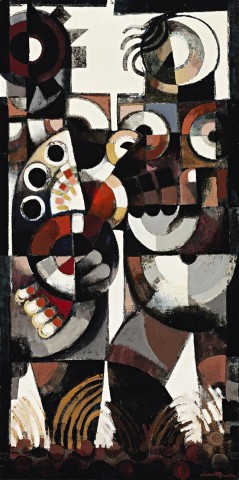MAN AND WOMAN WITH A BIRD, c.1955
LEONARD FRENCH
enamel on hessian on composition board
122.0 x 61.0 cm
signed lower right: Leonard French
Private collection
Sotheby’s, Melbourne, 2 May 2000, lot 133 (as ‘Untitled, c.1958’)
Dr Jan Altmann, Melbourne
Sotheby's, Melbourne, 26 November 2013, lot 5
Company collection, Sydney
Possibly: Leonard French: Odyssey, Victorian Artists’ Society, Melbourne, April 1955
Leonard French is one of the most distinctive and individualistic artists to gain prominence in Australia during the post-war period. An Abstract Symbolist, his unusual training as a signwriter augmented by part-time art classes informed both his technique and his aesthetics. His utilisation of industrial enamels and glazes gives his paintings an appearance of solidity, even indestructability, and Man and Woman with a Bird, c.1955, is a vividly precise and engaging example from his early years in the local scene.
As part of his sign-writing apprenticeship, French attended Melbourne Technical College1 for trade classes which were held in the same building as the art classes. Noticing his talent, the painting lecturer Victor Greenhalgh ‘took him under his wing, invited him to evening classes and later gave him responsibilities teaching other students of techniques for preparing art materials’.2 After classes, he became a regular at the Swanston Family Hotel in Swanston Street, a pub also patronised by many of Melbourne’s emerging artists including Arthur Boyd, John Perceval, Clifton Pugh, Charles Blackman and future gallery director Laurie Thomas; indeed, given his assertive nature and strongly argued beliefs, this regular gathering became known as ‘Len French’s University’.3 What this meant was that whilst French was developing a singular understanding of materials and techniques through his teaching and sign-writing studies, he was also honing a particular vision of artistic practice bolstered by his debates with personalities who were largely responsible for setting the course of the Australian art scene for the next decade and beyond. He traveled to London in 1949 and, in the following year, saw a major retrospective of works by Fernand Léger at the Tate Gallery which had a profound impact, one which went ‘considerably beyond a formal or stylistic influence; what appealed (to French) was the whole philosophy of art into life, of monumental art within architecture’.4 French was also an avid reader and through this confluence of ‘imaginative catalysts’ he developed ‘recurring theme(s) of heroic grandeur and the heroic quest’5 in his subsequent exhibitions. Based on Homer’s epics, the Iliad and the Odyssey, these shows featured images rich with an array of personalised symbols including birds, fish and wheels. For Man and Woman with a Bird, French employed a further tactic of covering the board with rough hessian before applying multiple layers of enamel paint, a method which gives the work a surprising tactility balancing the otherwise severe edges of the design. The painting’s smaller scale also provides an intimacy often missing from French’s larger works as the depicted couple engage in a ritual of mutual exchange and care for their avian companion.
Man and Woman with a Bird was for many years a part of the extensive collection of Australian art acquired by John and Jan Altmann, generous benefactors to the National Gallery of Victoria, Melbourne. Apart from major tapestries by Charles Blackman and John Perceval, the Altmanns also owned a significant selection of paintings by Roy de Maistre, including Portrait of Francis Bacon (1935), The Footballers (c.1938), and Jacob Wrestling the Angel (1958).
1. Later re-named the Royal Melbourne Institute of Technology.
2. Grishin, S., Leonard French, Craftsman House, Sydney, 1995, p. 15
3. See Heathcote, C., A Quiet Revolution: the rise of Australia art 1946-1968, Text Publishing, Melbourne, 1995, p. 63
4. Grishin, S., op cit., pp. 8 – 9. Other influences include Celtic art, and the massed planes, mood and gravitas found in the paintings of Marcel Gromaire and Constante Permeke.
5. Waldren, M., ‘The Renaissance Man’, The Weekend Australian, 13 November 1999
ANDREW GAYNOR
